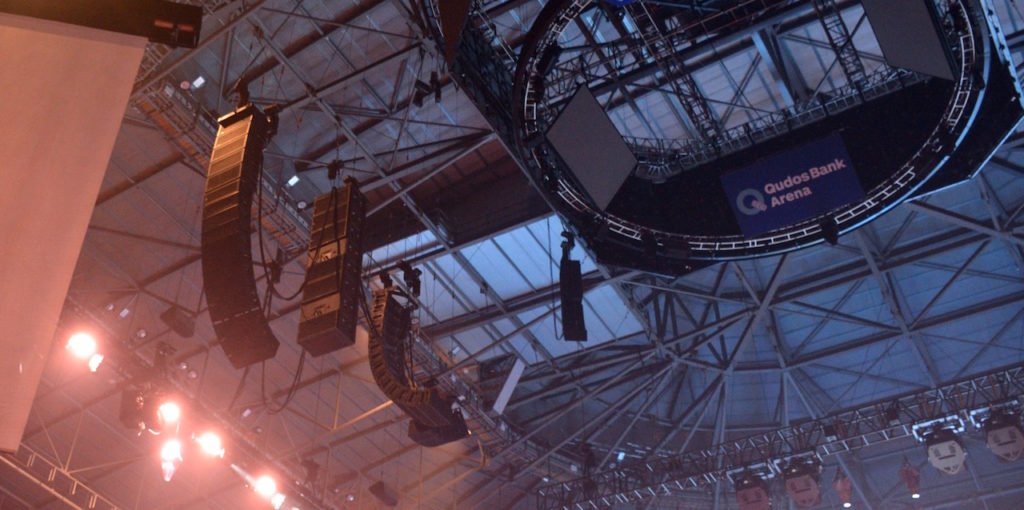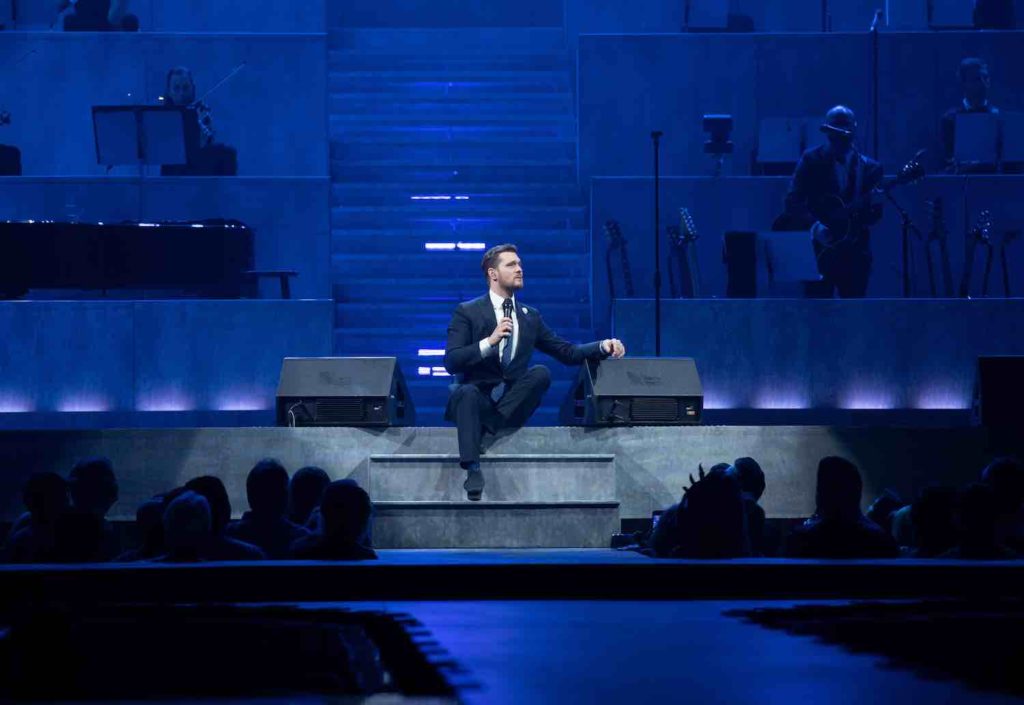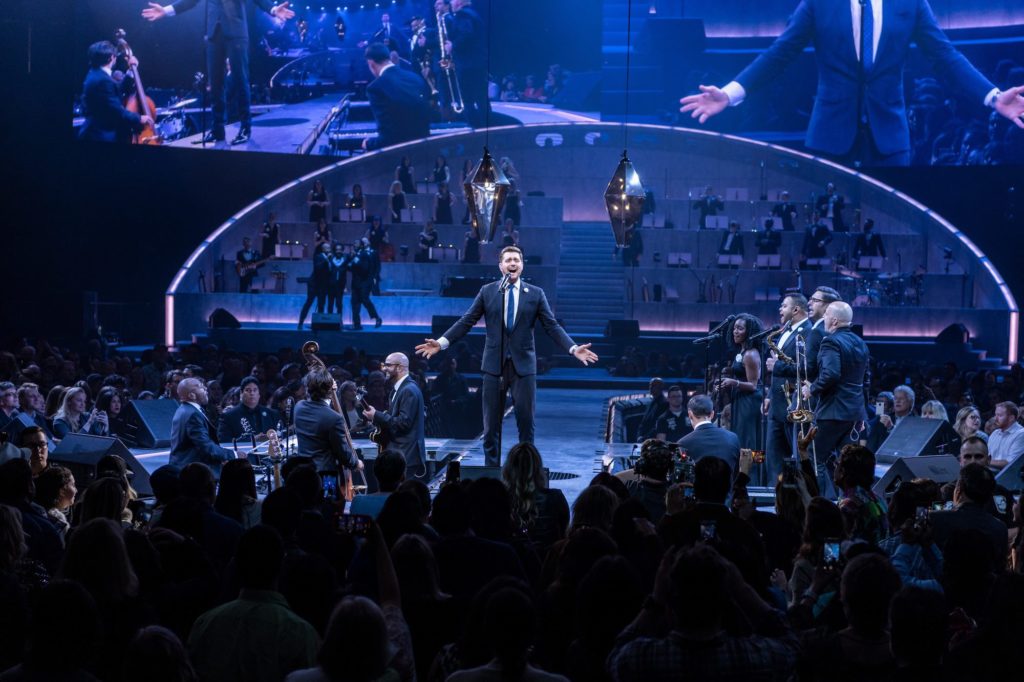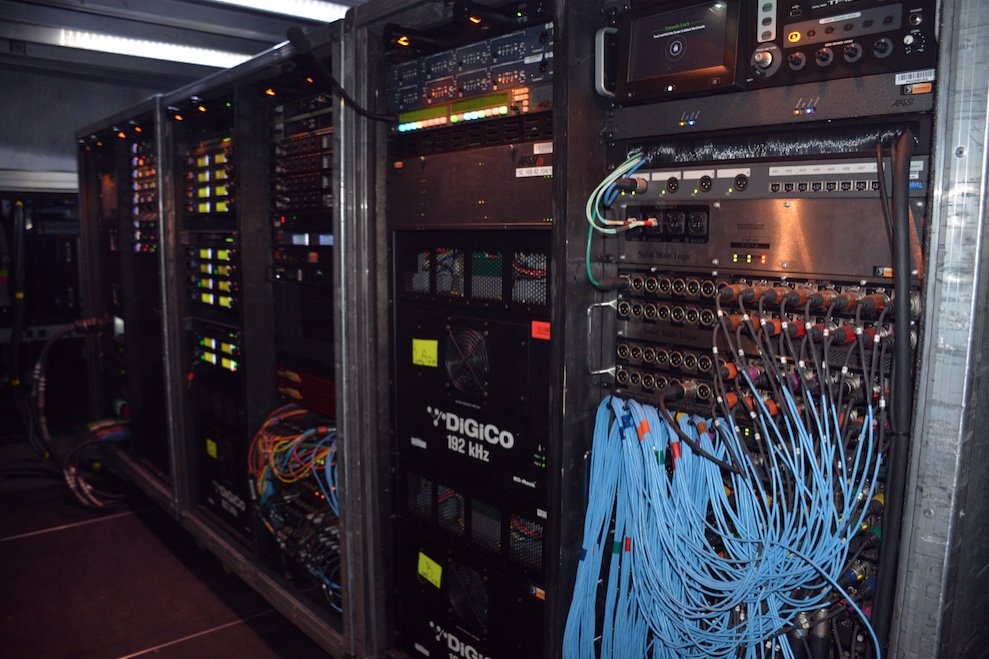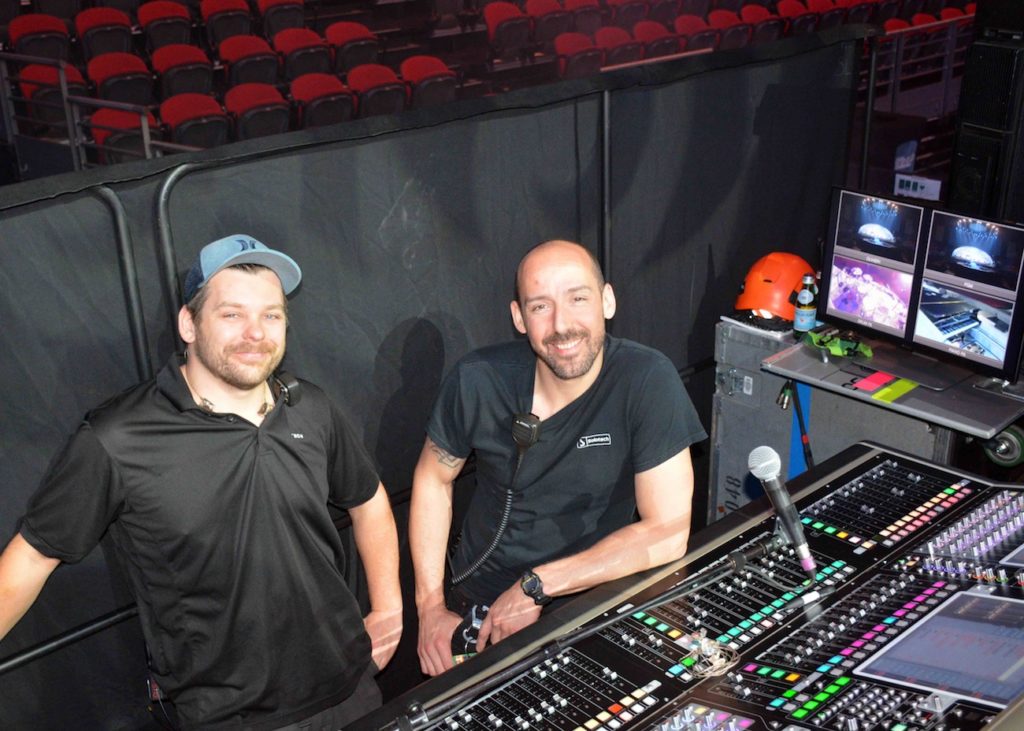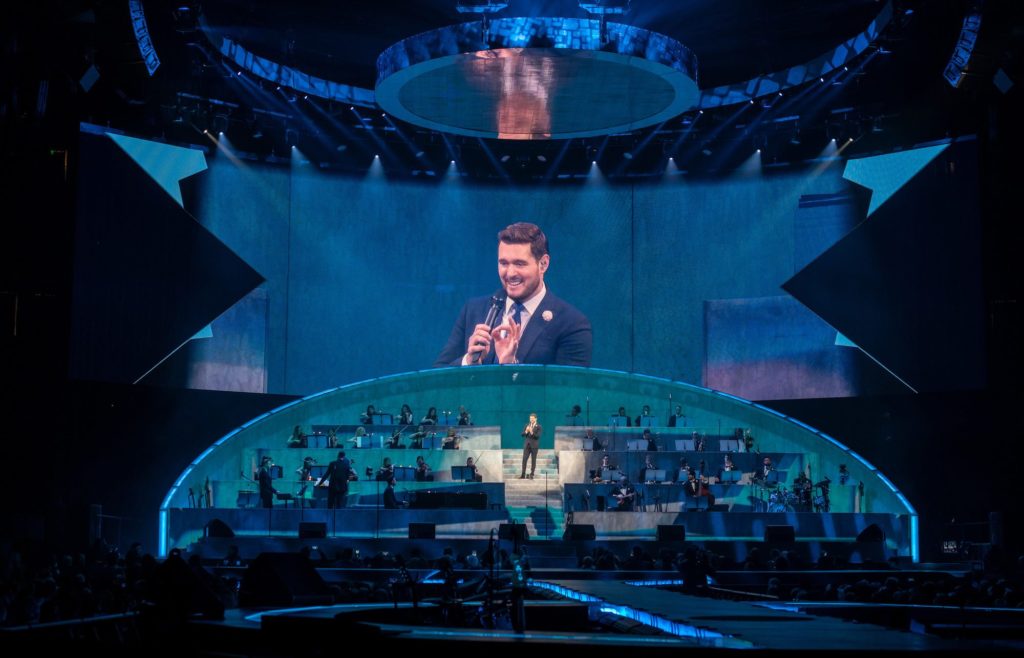News
9 Mar 2020
Michael Bublé
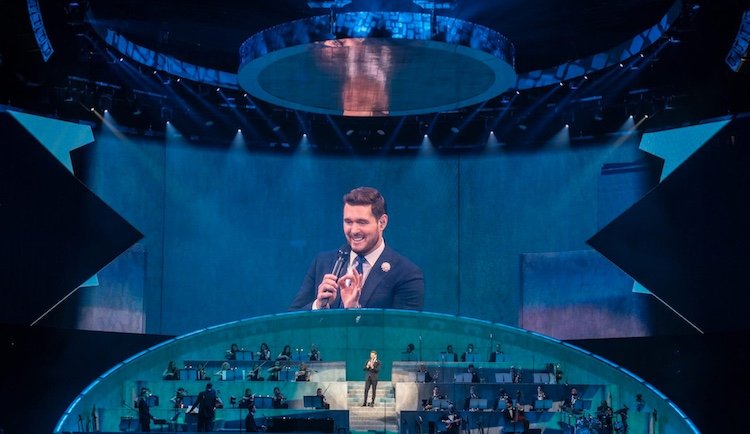
Subscribe to CX E-News
Modern-day pop acts could learn a thing or two about performance from this seasoned star who fills his gig with warmth, personality, and spades of talent.
Michael Bublé’s world tour, An Evening With Michael Bublé, a celebration of his 10th studio album, toured Australia and New Zealand through February.
Mixing FOH was Craig Doubet on his fourth full length world tour with Michael, every tour having had one major thing in common; they all utilised a Meyer Sound system.
Audio gear and crew were supplied by Solotech with approximately 200 Meyer Sound cabinets helping to fill the 19 trucks on the road.
“I was involved in the overall design of the show because of how Michael wanted to be heard,” said Craig, who has mixed Michael since 2007.
“So we came up with an idea and they said ‘great, what about all these lights?’ and so the physical look of the show was altered to accommodate what we’re doing with audio – so I’ll take that as a win for the audio team!”
To be fair, Michael is so charismatic he could play on an empty stage and still bring the house down. The artist himself says this tour is primarily about music and sound.
On stage, there is a five-piece rhythm section, three backing vocalists, a thirteen-piece brass section, sixteen strings and a conductor.
Craig Doubet studied audio technology at Indiana University’s School of Music, graduating in 1986, before spending several years in a recording studio. His first foray into mixing FOH was for Latin star Luis Miguel in 1995 and since then he has never looked back mixing k.d. lang, Sergio Mendes and Monica Mancini, amongst others.
“I enjoy mixing in other languages!” Craig remarked. “It’s interesting to treat the vocal more like a sound and if you don’t understand it, I find it can actually help you.”
Craig is a big fan of Meyer Sound, saying he has been using their loudspeakers since 1995 because they simply just work for him, “I open the box, I open the channel and I think ‘that sounds like a vocal’. Every day.”
The main stage system for the tour comprises a total of 16 LEO and 44 LYON line array loudspeakers configured across the front, outfill, and side systems. Twelve 1100-LFC low-frequency control elements are flown at the main stage, with front fill from eight MINA and two JM-1P loudspeakers and floor bass anchored by four 900-LFC elements.
“The LEO and LYON combination for vocals is unbelievable, it’s the meat of the PA, and technically there’s no phase flop in it until very low,” added Craig.
“It just sounds very natural and it’s a very rich box that works really well for this type of music. It’s the same with the LYONs on the side array so I try to keep the package all the ‘L brand’ as we call it.
“The good thing about Meyer Sound now is that their GALAXY processors can make the older M Line sound more like an L line by putting in All-pass filters and fixing the way that it responds.”
The string section is local to whichever city they are playing so the audio department has to be ready and quiet by 4PM on show day so they can rehearse.
It was Michael himself who wanted to perform out front on a B-stage as freely and easily as possible, it was up to Craig and his team to work out how to make the audio focus on him and so that Michael can hear himself.
The B-stage system comprises two long-throw arrays each with five LEO-M and twelve MICA line array loudspeakers; side arrays of 14 each MICA loudspeakers; and stage-facing rear arrays of eight-each LEOPARD line array loudspeakers.
Flown subwoofers here are 12 700-HP, with two 900-LFC elements on the floor along with seven MINA loudspeakers for front fill. System drive and optimization are supplied by a GALAXY 816-AES3 master processor networked via AVB with seven GALAXY 816 array processors.
“The B-stage rig is really part of the main PA,” explained Craig. “I use it as a delay and it fills the back of the house. I like to think of it as a distributed PA so most of the time, there are really six arrays doing the entire room.
“It gives the intimate feeling that Michael really likes. I’m using MICAs because they’re very flexible in that they can open up wide but still keeps it fairly compact.”
In some venues which have lower ceilings, such as Adelaide Entertainment Centre, it can be tricky to work out how high the speakers can be versus the lights that illuminate him up on the B-stage and catwalk.
For ten minutes of the show, the B-stage turns into an in-the-round performance area so Craig turns off the main speakers and uses only the speakers surrounding the B-stage.
Craig changes the time to ‘zero time’ for the PA so that Michael can take his IEMs out, if he wants, and treat it like he’s behind a PA, which he is.
The past two tours saw Michael utilising a B-stage but he was having a problem with his vocal from the main stage PA bleeding into his mic and then going into his IEMs. A delay of 125 to 160 milliseconds coming back into your ears when you’re trying to sing can obviously be quite distracting.
“So the other tricky thing that we’re doing is that any time he walks out to the B-stage from the main stage, his vocal follows him,” Craig elaborated.
“It pans from the main PA to the B-stage PA and back again. That way he never hears himself out of a speaker behind him and it’s also cool for the audience, although most don’t notice it, because the vocal follows the physical person.”
Michael likes to have wedges saying he likes to feel his ‘pant leg’ and so 15 Meyer MJF210 were located around the main stage and the B-stage.
When asked about his thoughts on Qudos Bank Arena, Craig said there was a bit of a low-end wobble but it was not horrible.
“The biggest problem I have is that I’m mixing in a not great location because we’re put where you’d normally be but the B-stage PA is practically over my head,” he elaborated.
“Plus we have a lot of obstructions to the PA such as a lighting truss that runs across and gets in the pattern as well as projection roll drops that come in and out of the show.”
In a throwback to his studio days, Craig was mixing on a Solid State Logic L500 adding that there were not many options as he has a high input and output count.
“At this level, I’d say DiGiCo SD7 or SD5 are the only other suitable options but I really like the workflow on the SSL which is less analogue in its approach to how it is presented,” said Craig.
“To me, that makes perfect sense as I don’t want to pretend it’s an analogue console anymore. I want to set it up the way I want it set up. On the SSL there are three ways of doing anything you want so your workflow is very varied. SSL is my audio DNA.”
The biggest challenge mixing Michael is that he likes to move the microphone as far away as possible from his mouth. He’s physically very loud but Craig has had a lot of experience with this type of mic technique as both Luis Miguel and k.d.lang perform in this manner.
“It’s not the problem of getting signal, it’s just the frequency response as the microphone moves,” he commented.
“Over time I have found the correct tools that work for that; essentially a dynamic EQ, not too much compression but most of keeping him in the mix is my finger.
“You don’t let go of a fader with a guy like Michael. On top of that, it’s a very dynamic show, it can be big and loud and then quiet and beautiful. In fact, the dynamic range is probably 25 – 30 dB.”
On the SSL there are three ways of doing anything you want so your workflow is very varied. SSL is my audio DNA.
The only outboard gear Craig utilises is a Universal Audio Live Rack 2, a new addition to his world. He has been a long-time user of Lexicon 480L or 960L and requested Lexicon for this tour but Solotech said the units were getting elderly.
Craig discovered the Universal Audio Live Rack 2 which he says has been great on all his reverbs.
The string section is local to whichever city they are playing so the audio department has to be ready and quiet by 4 PM on show day so they can rehearse.
“They’ll rehearse for up to an hour with the band joining in towards the end and then Michael will arrive for soundcheck for however long he wants, then often the strings will continue rehearsing so our time frame is really compressed,” Craig said.
In microphone world, Michael decided to go wireless so he can roam the catwalk and B-stage with ease, opting for a Sennheiser 6000 with a Neumann KK204 capsule.
“The beauty of this rig is that now his vocal gets digitised in the microphone, goes to the receiver from which we take the AES output which is then run through a device that splits the AES three-ways before going into all of our consoles,” explained Craig.
“The first time that Michael’s vocal becomes analogue is when it comes out of the speaker. It’s a nice clean path, super tidy with no extra conversions.”
The other vocals are on Shure Axient handhelds with DPA 4018S capsules. The horns are all DPA 4099s, and the strings are DPA 4060 Lavalier mics. The piano had a DPA 4031, the drumkit is mostly Sennheiser and Audix with Neumann 184s for the overheads and cymbals, and the DI boxes are all Radial.
Monitor engineers Marc Depratto and Louis-Philippe Maziade were both using DiGiCo SD7 Quantum consoles, chosen for their flexibility, with Marc mixing Michael and the quintet, and Louis-Philippe mixing the orchestra and conductor.
“Due to a heavy channel count, 130 inputs and 96 outputs, we had to step up to the Quantum engine,” said Marc. “The SD series has a specific tone that I really like and I believe it’s the closest to analogue that the digital world can offer.
“Michael likes to hear a full mix so my left and right buss basically go into Michael’s ears so I mix it like I would mix a FOH position.
“With Michael moving away from the mic so much we have to be very careful of the stage level, as soon as he distances himself from the mic you have the brass and drums leaking into his mic so I put a Rupert Neve Portico 5045 on inserts on his mic to reduce the leakage which works really well.”
Outboard there are two Lexicon PCM 92 reverbs for vocals, one for Michael and one for backup singers. Everything else is on board, with Marc noting that with the Quantum engine, they have dynamic EQs and compressors, and pretty much everything else they would require.
“Since we stepped up to 96K we try not to have too much in and out conversion for nothing so we try to keep it all onboard which is much more efficient,” he added.
“We’re running 42 stereo mixes right now, spread between two consoles.”
The first time that Michael’s vocal becomes analogue is when it comes out of the speaker. It’s a nice clean path, super tidy with no extra conversions.
The main challenge for Marc and Louis is the sheer size of the orchestra. As said previously, it’s a very dynamic mix, which they have to make sound good and consistent every day.
Louis mixes all of the orchestra, conductor and backing vocals with particular importance on the conductor as he drives the orchestra.
With a fresh orchestra at every show, time is the enemy, and orchestra members are not used to IEMs, however they are really important so they can hear the conductor, the click and the instrument itself.
“There are so many microphones open on stage at the same time it’s like a cat and mouse chase, you really need to know the parts when they’re on and not on,” said Louis.
“Everyone is using IEMs, the Shure PSM 1000 system with all using Ultimate Ears UE-11s, as Michael only uses the wedges to add depth to his vocal, he has such a low voice it’s not only about hearing it but also feeling it.”
The show is recorded every night with Avid Pro Tools recording via MADI.
CX Magazine – March 2020
LIGHTING | AUDIO | VIDEO | STAGING | INTEGRATION
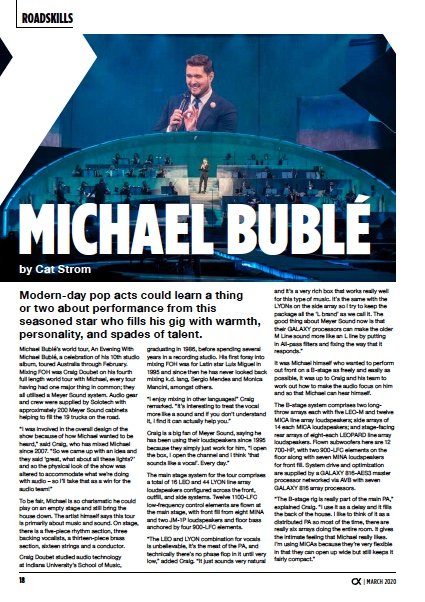
Entertainment technology news and issues for Australia and New Zealand
– in print and free online www.cxnetwork.com.au
© VCS Creative Publishing
Subscribe
Published monthly since 1991, our famous AV industry magazine is free for download or pay for print. Subscribers also receive CX News, our free weekly email with the latest industry news and jobs.


